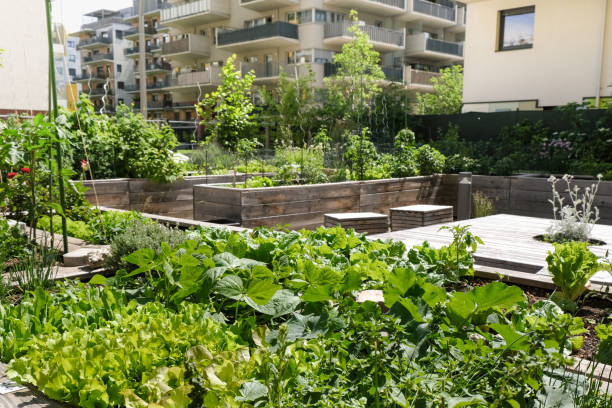Small-space solutions for productive urban plots
Urban plots can be surprisingly productive with targeted planning and techniques that respect environmental and spatial constraints. This overview highlights sustainable approaches for compact yards, balconies, and courtyards, including soil improvement, efficient irrigation, pollinator support, and strategies for growing edibles and indoor plants.

Limited area, mixed sun exposure, and shared microclimates are common challenges on urban plots, but they also create opportunities for focused, efficient design. With careful planning you can prioritize sustainability, biodiversity, and year-round productivity. This article explains practical methods—from composting and mulching to xeriscaping and hardscaping—that make small outdoor spaces productive while reducing inputs. Emphasizing layered plantings, adaptable containers, and maintenance-smart pruning techniques helps both new and experienced gardeners produce food, support pollinators, and create attractive, resilient outdoor rooms in constrained sites.
How does sustainable landscaping work in small plots?
Sustainable landscaping for compact plots reduces resource use and boosts ecological value. Focus on permeable materials for paths, minimize turf, and select native plants that suit local conditions to lower water and fertilizer needs. Group plantings by light and moisture requirements so maintenance and irrigation are targeted rather than wasteful. Use reclaimed or low-impact materials for hardscaping elements like benches and raised beds to define functional zones without stealing planting area. Planning in layers—groundcover, mid-height perennials, and vertical climbers—maximizes production and habitat in the same footprint.
What gardening and composting approaches fit tight spaces?
Containers, vertical planters, and compact raised beds increase usable growing area and simplify soil control in urban plots. Use a light but fertile container mix, and replenish with finished compost to maintain structure and nutrients. Small-scale composting options—worm bins (vermicomposting) or tumblers—work well where space is limited or neighborhood rules restrict outdoor piles. Regularly top-dress beds with compost to improve water retention and feed soil life. For very small balconies, adopt a rotation of potting and replenishment so soil quality remains high without bulky equipment.
Which irrigation and mulching methods save water and time?
Efficient irrigation is essential in small plots to prevent stress and conserve water. Drip lines and soaker hoses used with timers or moisture sensors deliver water precisely to root zones. For tiny spaces, targeted watering with a can can be effective if done consistently. Mulching with organic materials—shredded bark, straw, or composted leaf matter—reduces evaporation, suppresses weeds, and moderates temperature. Apply a 2–4 cm mulch layer and refresh yearly; avoid piling mulch against stems to reduce rot. These techniques cut watering frequency and support plant health.
How can pollinators be supported using native plants?
Even compact urban plots can support pollinators by including native plants that provide nectar and pollen across seasons. Choose a mix of early, mid, and late bloomers and incorporate small clusters of flowers rather than single isolated pots to make resources visible to bees and butterflies. Avoid broad-spectrum pesticides and offer shallow water sources or flat stones for drinking. Native grasses and low shrubs provide shelter and nesting habitat. Grouping pollinator-friendly plants near edibles increases fruit set in compact vegetable patches.
When is xeriscaping and hardscaping appropriate for small yards?
Xeriscaping principles—reducing water needs through plant selection and design—are useful in small urban plots, particularly where irrigation is costly or restricted. Use drought-tolerant species and arrange them in hydrozones so plants with similar needs are grouped together. Hardscaping can increase usable area by incorporating raised planter benches, narrow patios, or integrated storage within retaining walls. Choose permeable pavers to maintain infiltration and connect rain capture features to planters. These strategies conserve water and create functional outdoor rooms in minimal space.
What strategies help grow edibles and manage indoor plants with pruning?
Edibles suited to small plots include herbs, leafy greens, dwarf fruit trees, bush beans, and compact tomatoes. Succession planting keeps harvests steady in limited beds, and companion planting with flowers enhances pollination. Indoor plants extend growing possibilities—start seedlings or grow herbs under supplemental light before moving them outdoors. Regular pruning improves vigor and yields: pinch herbs to encourage branching, remove dead or crossing branches on fruiting shrubs, and thin dense canopies to allow light and airflow. Pruning also keeps plants within spatial limits and reduces pest pressure.
Conclusion
Productive urban plots rely on intentional design: sustainable landscaping, smart use of containers and composting, precise irrigation and mulching, and plant choices that favor native species and drought tolerance. Integrating hardscaping thoughtfully and maintaining plants through pruning and succession planting helps maximize yields, support pollinators, and create low-maintenance, resilient green spaces in compact urban settings.





